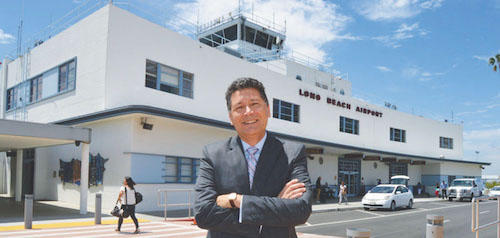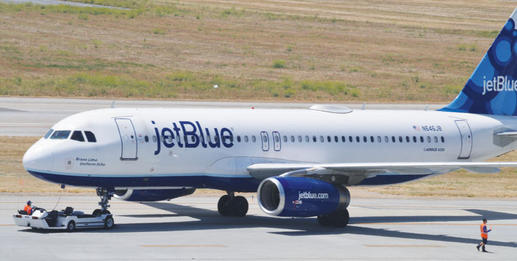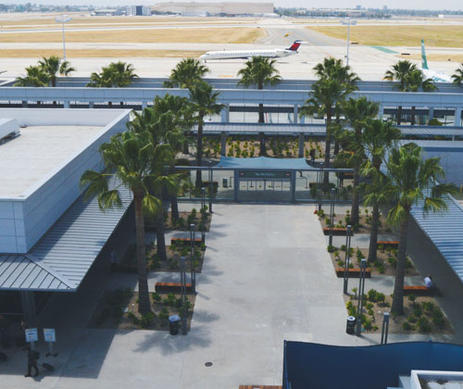In 2016, approximately 2.8 million passengers traveled through Long Beach Airport. Director Jess Romo and airport staff project 3.5 million passengers will pass through the airport’s terminal this year, which will be the most annual passengers in the airport’s 94-year history.
“We still have half of the year to go, so we have to wait and see how that might actually materialize,” Romo said. “But based on our look-ahead schedule – we require all our carriers to supply their six-month schedule in advance – we see through November a continuation of full utilization of those slots.”

Long Beach Airport Director Jess Romo said staff projects 3.5 million passengers will travel through the airport this year, a record for the 94-year-old facility. (Photograph by the Business Journal’s Larry Duncan)
The slots referenced by Romo are, of course, those permitted by Long Beach’s strict noise ordinance, which limits the number of flights and flight times to maintain the quality of life for surrounding residents. Under the ordinance, 50 commercial flights are permitted daily, flown by six operators. JetBlue Airways holds 35 slots, Delta five, and FedEx and UPS one each.
Until recently, American Airlines held four slots but in February announced that it was giving up two slots, which were then allocated to Southwest. When Southwest takes over the flight slots in August, it will operate six daily flights out of Long Beach, including two to Sacramento, its latest addition.
According to Romo, prior to Southwest beginning operations at Long Beach Airport early last year, carriers – JetBlue in particular, as the largest carrier in the city – had a tendency to not utilize flight slots fully. However, with a new competitor chomping at the bit to utilize as many slots as possible, Romo said slot utilization has been between 95% and 98%.
After the Long Beach City Council’s January decision to not approve the addition of a federal inspection station at the airport to allow for international flights, some speculated a reduction in service from JetBlue, which initially requested the facility. Based on scheduling for the remainder of the year, this does not seem to be the case; however, Southwest has stated it would take over as many flight slots as it can at the airport.
“That helps us as the airport operator,” Romo said. “If an airline decides to make some adjustments, perhaps pull down their schedule partly or sizably, it’s good to know that there’s at least one carrier that has expressed interest in growing here.”
Romo noted that the airport respects the council’s decision on international flights and will continue to work with carriers and other airport partners to grow business opportunities within current regulations and be proper stewards of the airport.
The airport and its tenants generate more than $10 billion and 45,000 jobs in the Long Beach region, with an estimated $1.1 billion in tax revenue at the federal, state and local levels. During the first quarter of this year, the airport itself generated $11.3 million, a 35% increase compared to the first quarter of 2016. Last year, the airport generated $38 million in operating revenue.
No General Fund monies go toward operating and maintaining the airport. Instead, operating revenue is put into the Airport Fund, which “remains in a strong financial position with no major concerns,” according to airport staff. “In fact, Moody’s Ratings Agency has expectations that Long Beach Airport ‘will produce financial metrics in-line or above current level’ and that ‘enplanements will continue to experience positive growth.’”

JetBlue is the largest commercial carrier to fly out of Long Beach Airport, with 35 flight slots out of the 50 daily flights allowed by the airport’s strict noise ordinance. JetBlue flies to Anchorage (seasonal), Austin, Boston, Ft. Lauderdale, Las Vegas, New York, Oakland, Portland, Reno, Sacramento, Salt Lake City, San Francisco, San Jose and Seattle. (Photograph by the Business Journal’s Larry Duncan)
In addition to paying for operations and general maintenance of the airport, the fund also pays for capital improvement projects, such as the $13.5 million runway 25L improvements, set to begin in September and be completed in August 2018.
“[We’re] soliciting bids for that rehabilitation and reconstruction project, which must be received by early June,” Romo said. “Everything will be built to at least a 20-year life – that’s required of the FAA so we can be eligible for the grant money that has been set aside to do that project. That’s probably our single largest capital project that we have going on right now.”
Romo explained that the project requires rebuilding the foundation of the runway at either end, due to added stress of takeoffs and landings, as well as the repaving of the entire runway with special FAA approved asphalt. He said he expects to request city council approval for the project as early as July.
The airport is currently under construction on $4 million in improvements to Lot A, a project that began in January and is scheduled to be completed by the end of October. This project includes new elevators and staircases, vehicle entry and exit point modifications, lighting and interior paint, and parking space restriping.
Bird mitigation to the tune of $150,000 is another improvement being discussed for the concourse, which would include double doors, a glass wall at both restaurants and nets to keep birds from entering the open area.
“We’ve got this great indoor-outdoor feel, and I think people are really, really attracted to that. Because of our indoor-outdoor feel, it’s also an opportunity for birds to be attracted,” Romo said. “Our engineering group is currently looking at things we can do in the open ceiling area and also ways to make sure that they don’t get in in the first place. We want travelers in there, not birds.”
Other improvement projects include Keystone Building repositioning and entry beautification. Construction has already begun on the Keystone Building, located at 4401 Donald Douglas Dr., just before visitors reach the airport’s valet parking facility. Once renovations to the existing building are complete, at least 30 security, engineering and accounting staff members will be relocated to the central location, some currently working from trailers. The first floor will consist of office space and a conference room, while the second will have additional office space, men’s and women’s locker rooms, and a storage area.
The estimated $570,000 entry beautification project includes an airport monument sign, which is currently in the design phase and could be completed as early as fall, and improved lighting. The project also includes entry wall improvements, which include replacing fencing with a 10-foot-tall concrete wall. Wall improvements are scheduled to begin in August and be completed in October.
An operational change coming to the airport is an update to the minimum standards for companies, which were last adopted in 2008. Romo explained that typically these guidelines are updated every five years and that open-house sessions will be held to get operator feedback. He said minimum standards are a way to address any imbalance or lack of a level playing field among the various companies operating at the airport.

Airport engineers are currently working on a project to keep the outdoor concourse area bird free, according to Airport Director Jess Romo. He said the team is considering glass walls and nets with the hopes of maintaining the attractive indoor-outdoor feel. (Photograph by the Business Journal’s Larry Duncan)
Prior to becoming director of Long Beach Airport, Romo oversaw Ontario and Van Nuys airports and was interim deputy executive director for operations and emergency management at Los Angeles International Airport. Romo is now eight months into his leadership at Long Beach, having started the position last September.
“I’m hoping that what [staff] is seeing is that what I wanted to do, number one, was to make sure I was really sensitive to making myself available to learn everything I could about the airport, the staff and the airport’s relationship to the city, the community and the leaders downtown,” Romo said.
Romo explained that his vision for the airport is to build a team that is fully engaged and excited about what is being done at the airport. He said that, for him, an airport is the most fun place to work because of the variety, challenges to overcome and relationships to be made, especially with a staff as small as the one at Long Beach Airport.
Additionally, Romo said he hopes to continue to diversify revenue streams, thereby making the airport rely less on aeronautical revenue streams. He said staff is looking at all opportunities to maximize returns on assets.
“You want the investment portfolio to be as varied as you can so that when one part of the market is not performing as strong as another part, you’ve got some other aspects that will help shore up during times that might be a little difficult,” Romo said.
One aspect of the job that Romo said was not completely unexpected – but he had to experience firsthand to fully appreciate – is how important an issue the airport is to the community. He said whether it’s those on the side of supporting operations and growth or those making sure it stays within its prescribed limits, people care and voice their concerns often.
Romo explained that he has come to respect residents on both sides of the issue because he recognizes the airport’s role as a member of the community. He said the airport exists to provide safe and efficient air travel, while supporting business and obeying regulations that have been set forth. This includes addressing the concerns of a large number of residents.
“The future of Long Beach Airport is good. I think folks want to have airports that are accessible, that are easy to get through, that are friendly – which we are,” Romo said. “I think we are in that enviable position where we’ve got this great small hub airport but still provide really nice service, and you can get to a lot of places from Long Beach.”
